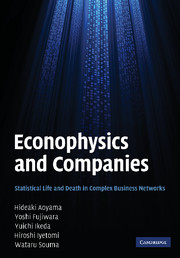Book contents
5 - An agent-based model for companies
Published online by Cambridge University Press: 06 August 2010
Summary
In Chapters 2 and 3 we investigated various statistical properties of companies by treating them as a statistical ensemble. In the preceding chapter we demonstrated that companies are interconnected through transaction relations, shareholdings, cooperative filing of patents and so on, thus resulting in the formation of a complex network. In this chapter we introduce the results of recent studies elucidating the dynamics of interacting companies using agent-based models.
The agents appearing in economic phenomena comprise consumers, investors, companies and others, and we can regard economic phenomena as many-body systems in which a number of those agents interact. Such an approach is called an agent-based simulation. Recently more and more simulations of various economic phenomena have been carried out using computers.
In computer science, an agent means a small piece of software possessing such properties as autonomy (acting with its own ‘will’), social nature (collaborating with another) and adaptability (making itself fit to its surroundings). These features of the agent exactly coincide with the agent-based model considered in this chapter.
So we might say that economic agents are the actors and the stage is a network connecting those agents. But what drama is played out in this theatre? We will begin by modelling the dynamics of companies as a stochastic process and then proceed to an explanation of agent-based modelling of companies.
Gibrat's process
In the present context we refer to the income, assets and number of employees attributed to a company as its complete ‘size’.
- Type
- Chapter
- Information
- Econophysics and CompaniesStatistical Life and Death in Complex Business Networks, pp. 152 - 183Publisher: Cambridge University PressPrint publication year: 2010



